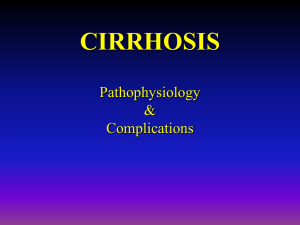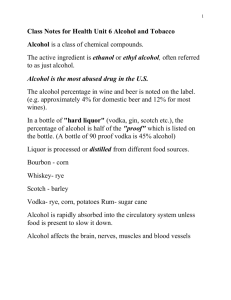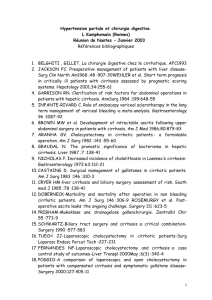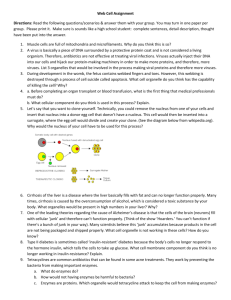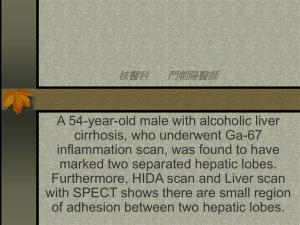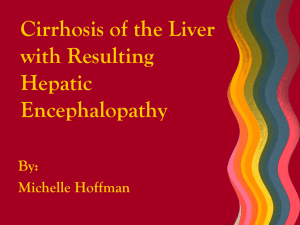Original Document: CIRRHOSIS Cirrhosis is a consequence of
advertisement
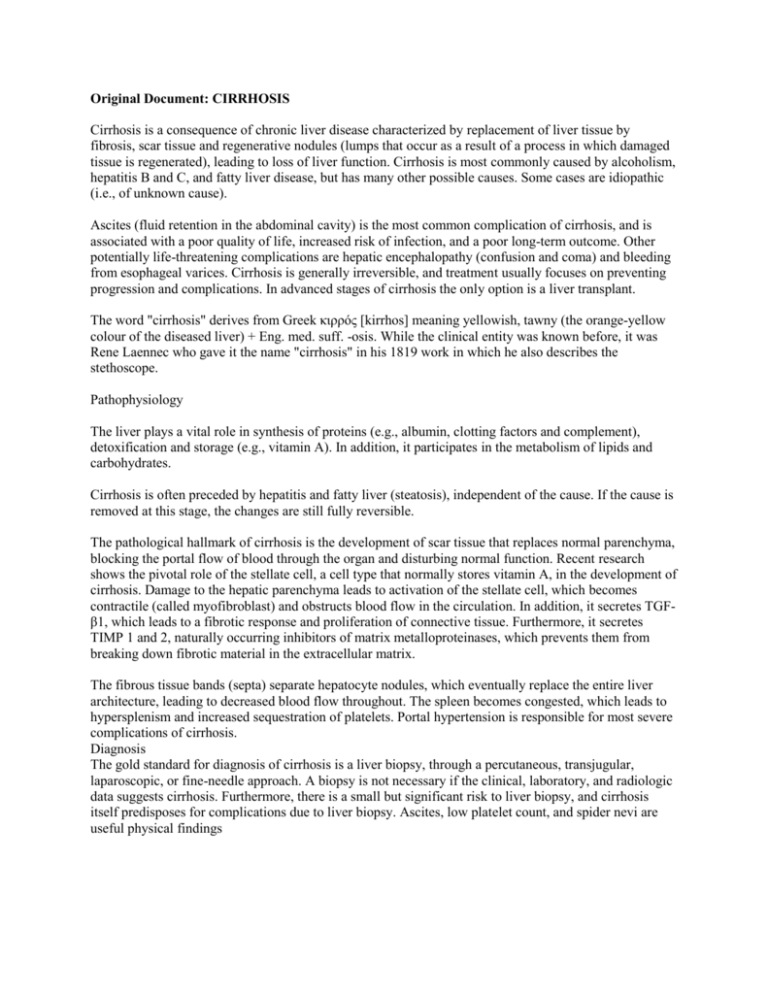
Original Document: CIRRHOSIS Cirrhosis is a consequence of chronic liver disease characterized by replacement of liver tissue by fibrosis, scar tissue and regenerative nodules (lumps that occur as a result of a process in which damaged tissue is regenerated), leading to loss of liver function. Cirrhosis is most commonly caused by alcoholism, hepatitis B and C, and fatty liver disease, but has many other possible causes. Some cases are idiopathic (i.e., of unknown cause). Ascites (fluid retention in the abdominal cavity) is the most common complication of cirrhosis, and is associated with a poor quality of life, increased risk of infection, and a poor long-term outcome. Other potentially life-threatening complications are hepatic encephalopathy (confusion and coma) and bleeding from esophageal varices. Cirrhosis is generally irreversible, and treatment usually focuses on preventing progression and complications. In advanced stages of cirrhosis the only option is a liver transplant. The word "cirrhosis" derives from Greek κιρρός [kirrhos] meaning yellowish, tawny (the orange-yellow colour of the diseased liver) + Eng. med. suff. -osis. While the clinical entity was known before, it was Rene Laennec who gave it the name "cirrhosis" in his 1819 work in which he also describes the stethoscope. Pathophysiology The liver plays a vital role in synthesis of proteins (e.g., albumin, clotting factors and complement), detoxification and storage (e.g., vitamin A). In addition, it participates in the metabolism of lipids and carbohydrates. Cirrhosis is often preceded by hepatitis and fatty liver (steatosis), independent of the cause. If the cause is removed at this stage, the changes are still fully reversible. The pathological hallmark of cirrhosis is the development of scar tissue that replaces normal parenchyma, blocking the portal flow of blood through the organ and disturbing normal function. Recent research shows the pivotal role of the stellate cell, a cell type that normally stores vitamin A, in the development of cirrhosis. Damage to the hepatic parenchyma leads to activation of the stellate cell, which becomes contractile (called myofibroblast) and obstructs blood flow in the circulation. In addition, it secretes TGFβ1, which leads to a fibrotic response and proliferation of connective tissue. Furthermore, it secretes TIMP 1 and 2, naturally occurring inhibitors of matrix metalloproteinases, which prevents them from breaking down fibrotic material in the extracellular matrix. The fibrous tissue bands (septa) separate hepatocyte nodules, which eventually replace the entire liver architecture, leading to decreased blood flow throughout. The spleen becomes congested, which leads to hypersplenism and increased sequestration of platelets. Portal hypertension is responsible for most severe complications of cirrhosis. Diagnosis The gold standard for diagnosis of cirrhosis is a liver biopsy, through a percutaneous, transjugular, laparoscopic, or fine-needle approach. A biopsy is not necessary if the clinical, laboratory, and radiologic data suggests cirrhosis. Furthermore, there is a small but significant risk to liver biopsy, and cirrhosis itself predisposes for complications due to liver biopsy. Ascites, low platelet count, and spider nevi are useful physical findings Simplified Document: CIRRHOSIS Cirrhosis is a result of continuing liver disease marked by replacement of liver tissue by fibrosis (having too much connective tissue), scar tissue and regenerative nodules (lumps that occur as a result of a process in which damaged tissue is reformed), leading to loss of liver function. Scar tissue cannot do what healthy liver tissue does - make protein, help fight infections, clean the blood, help digest food and store energy. Cirrhosis is usually caused by alcohol addiction, hepatitis B and C (other diseases of the liver causing inflammation), and fatty liver disease, but has many other possible causes. Some cases result from an unknown cause, which is called idiopathic. Ascites (liquid collecting in the belly) is the most common complication of cirrhosis, and is linked with a poor quality of life, higher risk of infection, and a poor long-term outcome. Other possibly dangerous complications are hepatic encephalopathy (which can cause confusion and coma) and bleeding from esophageal varices (abnormally wide veins of the esophagus, which is the tube that carries food, liquids and saliva from the mouth to the stomach). Cirrhosis is generally not reversible, and treatment usually centers on stopping progression and complications. In advanced phases of cirrhosis the only choice is a liver transplant. The word “cirrhosis” comes from Greek kirrhos meaning yellow, tawny (the light brown to brownish orange color of the diseased liver) plus the English medical word ending -osis. While the disease was known before, it was Rene Laennec who gave it the name “cirrhosis” in his 1819 work in which he also describes the stethoscope. Pathophysiology The liver plays a critical role in the chemical change of proteins (for example, albumin, a kind of protein found in blood), clotting factors (proteins that are involved in the blood coagulation process) and complement (a protein that is found in the blood and is important for fighting infection), removing toxins and storage (for example, vitamin A). In addition, it acts in the metabolism of lipids (for example, fats) and sugars. Cirrhosis often comes after hepatitis and fatty liver (also called steatosis), independent of the cause. If the cause is removed at this stage, the changes are still fully reversible. The pathological characteristic of cirrhosis is the development of scar tissue that takes the place of the normal working part of the liver, blocking the portal flow of blood through the organ and disturbing normal function. Recent research shows the crucial role of the stellate (or star shaped) cell, a cell type that normally stores vitamin A, in the development of cirrhosis. Damage to the tissue of the liver leads to changes in the stellate cell, which contracts (called myofibroblast) and blocks blood flow in the circulation. In addition, it releases TGF- s1 which leads to a fibrotic response and growth of connective tissue. Connective tissue is supporting tissue that surrounds other tissues and organs. Furthermore, it releases TIMP 1 and 2, naturally occurring substances that stop matrix metalloproteinases (enzymes or proteins that speed up chemical reactions in the body), which keep them from breaking down fibrotic material in the network of fibers that hold cells together. The fibrous tissue bands (also called septa) separate liver cell nodes, which eventually replace the entire liver structure, leading to decreased blood flow throughout. The spleen becomes blocked, which leads to an enlarged spleen and increased separation of platelets (which help wounds heal and prevent bleeding by forming blood clots). Portal hypertension (high blood pressure in the vein that carries blood to the liver) is responsible for most serious complications of cirrhosis. Diagnosis The gold standard for diagnosis of cirrhosis is a liver biopsy (removal of tissue from the liver for microscopic examination), done through the skin, through the jugular (a vein in your neck that returns blood from your head), through the abdominal wall, or with fine-needle approach. A biopsy is not necessary if the medical examination, blood and urine tests, and radiologic image (such as x-rays or ultrasound) results suggest cirrhosis. Furthermore, there is a small but important risk to liver biopsy, and cirrhosis itself makes one susceptible for complications due to liver biopsy. Ascites, low platelet count, and spider nevi are useful physical findings.
